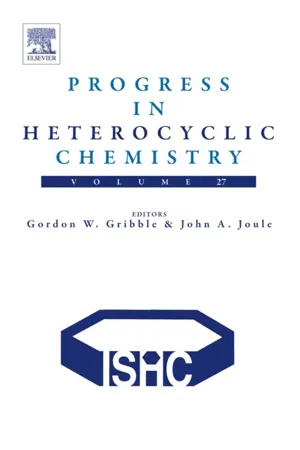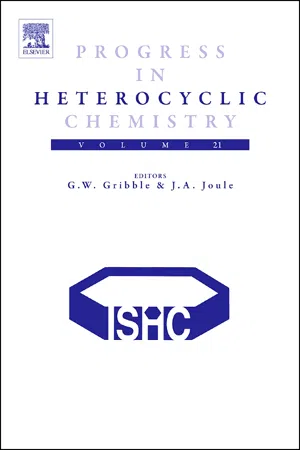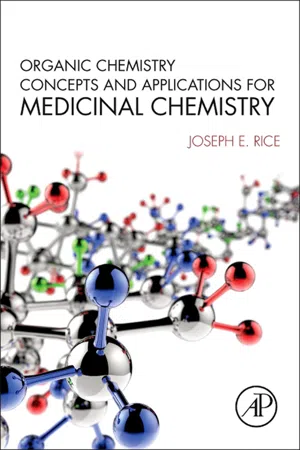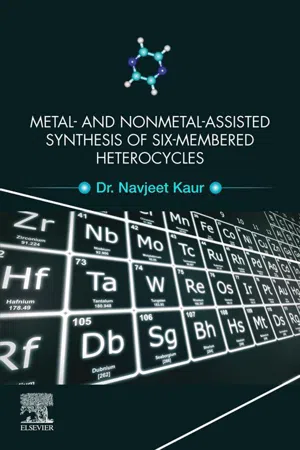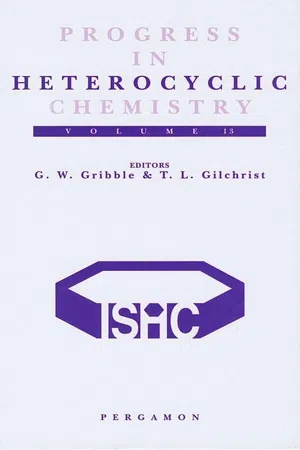Chemistry
Six Membered Ring
A six-membered ring is a cyclic organic compound that contains six carbon atoms in its ring structure. These rings are commonly found in many natural and synthetic compounds, including carbohydrates, amino acids, and steroids. The six-membered ring is an important structural motif in organic chemistry and is often used as a building block for the synthesis of more complex molecules.
Written by Perlego with AI-assistance
Related key terms
Related key terms
1 of 4
Related key terms
1 of 3
5 Key excerpts on "Six Membered Ring"
- eBook - ePub
- (Author)
- 2015(Publication Date)
- Elsevier(Publisher)
Chapter 6.4Six-Membered Ring Systems
With O and/or S Atoms
Clementina M.M. Santos1 and Artur M.S. Silva2 , ∗1 School of Agriculture, Polytechnic Institute of Bragança, Bragança, Portugal2 Departament of Chemistry & QOPNA, University of Aveiro, Aveiro, Portugal∗ Corresponding author: E-mail: [email protected]Abstract
This review highlights work published in the calendar year of 2014 on the O - and S -6-membered heterocyclic ring systems. Novel reaction chemistry, specific reagents, specific reactions, and new ring synthetic methods for pyrans, [1]benzopyrans, dihydro[1]benzopyrans (chromenes, chromans), [2]benzopyrans, dihydro[2]benzopyrans (isochromenes, isochromans), pyranones, coumarins, chromones, xanthenes, xanthones, thiopyrans, dioxins, dioxanes, trioxanes, tetraoxanes, and oxathianes are reviewed.Keywords
Benzopyran derivatives; Chromones; Coumarins; Di-, tri- and tetraoxanes; Dioxins; Oxathianes; Pyranones; (Thio)Pyrans; Xanthenes; Xanthones6.4.1. Introduction
In 2013, a large variety of publications dedicated to the synthesis O - and S -6-membered heterocycles emerged, with special emphasis on the synthesis of natural oxygen derivatives.The importance of microwave irradiation in the synthesis of O -6-membered compounds (14SC3047 ), the synthesis of several of their natural derivatives or key intermediates in a gram-scale fashion covering the literature from the twenty-first century (14NPR419 ), the isolation, synthesis and structural elucidation of the natural tetrahydropyran amphidinol 3 (14NPR468 ) and the chemistry of the secondary metabolite silybin, a 2-aryl-4H -chroman-4-one, were reviewed (14NPR1138 ). An overview of the natural occurrence, synthesis and biological properties of chromones (14CR4960 ), synthesis and structure-activity relationship of antileishmanial phenolic natural and synthetic flavonoids, isoflavones, coumarins and xanthones (14CR10369 ), the synthesis of natural products and natural-product-like compounds based on chroman-type structures (14SL1953 ) and the natural occurrence and synthesis of chromenes, coumarins and fused chromene-type compounds as well as the application of dihydrobenzo[h ]chromenes in the construction of various synthetic organic compounds (14CR10476 - eBook - ePub
- Gordon Gribble, J. Joule(Authors)
- 2009(Publication Date)
- Elsevier(Publisher)
Chapter 6.4: Six-Membered Ring Systems: With O and/or S Atoms
John D. Hepwort (email: [email protected] )
University of Central Lancashire, Preston, UKB. Mark Heron (email: [email protected] )
Department of Colour Science, School of Chemistry, University of Leeds, Leeds, UK6.4.1. Introduction
2008 saw the publication of the third edition of Comprehensive Heterocyclic Chemistry and Volume 7 contains chapters on the structure and reactivity < 08CHECIII(7)337 >, synthesis < 08CHECIII(7)419 > and applications < 08CHECIII(7)701 > of pyrans and their benzo derivatives and on thiopyrans and their benzo derivatives < 08CHECIII(7)727 >. Chapters on 1,2-, 1,3- and 1,4-dioxins, -oxathiins, -dithiins and their benzo derivatives appear in Volume 8 < 08CHECIII(8)677 , 08CHECIII(8)739 , 08CHECIII(8)857 > and Volume 9 includes a chapter on six-membered rings with 1,2,4-oxygen and/or sulfur atoms < 08CHECIII(9)569 >. Other reviews which relate directly to topics in this chapter include those on C-O bond formation leading to 6-membered oxygenated heterocycles < 08T2683 >, Meldrum's acid in the synthesis of natural products < 08CSR789 >, the value of the Petasis-Ferrier union/rearrangement in the construction of cis-2,6-disubstituted tetrahydropyran units present in natural products < 08ACR675 >, cycloaddition reactions of 3-oxidopyrylium betaines < 08T3405 > and thiochroman-4-ones < 08JSC623 >. More general reviews which refer to pyrans, thiopyrans and related systems include coinage metal-assisted synthesis of heterocycles < 08CR3395 >, Pd-mediated intramolecular biaryl coupling < 08H(75)1305 >, organocatalysis < 08OBC2037 >, the Baylis-Hillman < 08T4511 > and Nazarov < 08CEJ9292 > reactions and multicomponent reactions of carbonyl compounds < 08S1 >.A simple route to benzannulated [5,6]spiroketals with potential in natural product synthesis involves heating 2-hydroxybenzyl acetates in neat 5-methylene-?-butyrolactone. The reaction proceeds via an o-quinone methide which undergoes a hetero Diels-Alder (HDA) reaction with the methylene unit (Scheme 1 ) < 08SL2500 - Joseph E. Rice(Author)
- 2014(Publication Date)
- Academic Press(Publisher)
Chapter 1 . Pyridazine, pyrimidine, and pyrazine all have two nitrogens in the ring with the heteroatoms located at the 1,2-, 1,3-, and 1,4-positions, respectively. The DNA bases cytosine and thymine are derived from pyrimidine. The saturated nitrogen-containing rings in the bottom row are given the trivial names of piperidine, piperazine, and morpholine. They are prevalent in drug molecules. A six-membered ring that has one oxygen is called pyran and its sulfur analog is thiopyran. These rings contain the maximum degree of unsaturation that is possible. A six-membered ring can generally accommodate three double bonds. Neither oxygen nor sulfur however can be part of a double bond in a ring. Each is divalent and both valencies are used to form the ring. If a double bond formed from oxygen or sulfur, they would be trivalent, and would be positively charged. That is an unstable arrangement. In an odd-sized ring such as a five- or seven-membered ring, oxygen or sulfur can be the lone saturated atom when the ring has its maximum allotment of double bonds. In an even-sized ring such as a six- or eight-membered ring, the presence of oxygen or sulfur within the ring means that there will be one fewer double bond than the maximum number. Thus one other atom in the ring besides the heteroatom must be saturated. That position is indicated by a number followed by a capital H preceding the name as in 2H-pyran. Thus, the oxygen and 2-position are saturated and there are two double bonds, one at the 3,4- and the other at the 5,6-positions. Most six-membered rings containing two or more heteroatoms are named systematically. Note that the name generally ends with -ine and that the rings are assumed to have the maximum amount of unsaturation.Figure 6.2 Systematically named five-membered heterocycles.Figure 6.3 Some common saturated and unsaturated six-membered heterocycles.Rings of 7–10 members are named systematically, but using a clever device to indicate ring size. Consider that heptane is the name of a seven-carbon aliphatic compound. The first vowel–consonant combination that occurs in heptane is “ep”. Thus, a seven-membered heterocycle has a name ending with -epine. Table 6.1 lists the designations for 7–10 membered heterocyclic rings.Table 6.1 Nomenclature of Medium-Sized RingsRing Size Hydrocarbon Ring-Size Designator 7 Hep tane -epine 8 Oc tane -ocine 9 Non ane -onine 10 Dec ane -ecine The smallest rings consisting of three or four atoms have no special rules for their naming. Figure 6.4 shows the structure and name for several of the more common small rings.Figure 6.4 Several small-ring heterocycles.Rules for systematically naming and numbering fused polycyclic rings will be thoroughly reviewed in the next section of this chapter, but there are several such ring systems that are common and have been given trivial names. Some bicyclic rings are shown in Figure 6.5 . Note that in the compounds quinoline and 1H-indole, the nitrogen is located at the 1-position. Isomers in which the nitrogen is located at the 2-position are called iso quinoline and 2H-iso- Navjeet Kaur(Author)
- 2020(Publication Date)
- Elsevier(Publisher)
Chapter 6Six-membered O- heterocycles
Abstract
The rich activity of heterocyclic compounds in biological systems is important for agricultural, pharmaceuticals, and natural products. Heterocyclic compounds have provided a platform for the rapid exchange of research in the areas of pharmaceutical, organic, medicinal, and analytical chemistry. In the pharmaceutical industry over 75% of the top 200 branded drugs have heterocyclic fragments in their structures. Heterocyclic building blocks also have practical uses as components in antioxidants, dyestuffs, bases, copolymers, and ligands. Most of the organic compounds containing heterocyclic compounds show better biological activity than nonnitrogen compounds.Keywords
Metal; nonmetal; catalysis; synthesis; oxygen; heterocycle; six-membered heterocycle; pyran; lactone; benzopyranone6.1 Introduction
The rich activity of heterocyclic compounds in biological systems is important for agricultural, pharmaceuticals, and natural products. Heterocyclic compounds have provided a platform for the rapid exchange of research in the areas of pharmaceutical, organic, medicinal, and analytical chemistry [1a–c] . In the pharmaceutical industry over 75% of the top 200 branded drugs have heterocyclic fragments in their structures. Heterocyclic building blocks also have practical uses as components in antioxidants, dyestuffs, bases, copolymers, and ligands. Most of the organic compounds containing heterocyclic compounds show better biological activity than nonnitrogen compounds [2 –5] .Pyran derivatives constitute a useful class of heterocyclic compounds, which are widely distributed in nature [6] . The fused pyran ring skeleton is a well-known heterocycle and an important core unit in a number of natural products. Pyran and fused pyran derivatives have attracted a great deal of interest due to their association with various kinds of biological properties. Substituted benzo(b )pyran derivatives exhibit anticancer activities against three human cell lines even at very low concentrations [7 –10] . A number of 2-amino-4H -pyrans are used as pigments, photoactive materials, and potentially biodegradable agrochemicals [11 –13] . Naphthopyrans are a class of photochromic compounds and the molecules have the ability to generate a yellow color on being irradiated with ultraviolet light. Pyranochalcones have been reported to exhibit antimicrobial, antimutagenic, antitumor, and antiulcer activities [14 ,15] . Pyrans and fused pyran derivatives have attracted a great deal of interest due to their association with various kinds of biological properties. The pyran heterocycles embedded with other heterocyclic moiety either in the form of a substituent or as a fused component changes its properties and converts it into a novel heterocyclic derivatives [16a,b]- eBook - ePub
Progress in Heterocyclic Chemistry
A Critical Review of the 2000 Literature Preceded by Two Chapters on Current Heterocyclic Topics
- G.W. Gribble, Thomas L. Gilchrist(Authors)
- 2001(Publication Date)
- Pergamon(Publisher)
Chapter 6.4Six-Membered Ring Systems: With O and/or S Atoms
John D. Hepworth University of Hull, Hull, UKB. Mark Heron [email protected] Department of Colour Chemistry, University of Leeds, Leeds, UKINTRODUCTION
Reviews of saturated oxygen heterocycles <00JCS(P1)1291 >, routes to 2,2-dimethyl-2H -[1]benzopyrans <00H(53)1193 > and pyranonaphthoquinone antibiotics <00T1937 >, HIV-1 active Calophyllum coumarins <00H(53)453 > and of the application of β-halovinylaldehydes in heterocyclic synthesis <00H(53)941 > have appeared.Convergent syntheses of the trans -fused tetracyclic tetrahydropyran system have been described; both involve alkynic triflate coupling as a key step <00TL507 , 903 >. A two directional construction of tricyclic ethers involves a double ring closing metathesis (RCM) sequence applied to allylic, alkynyl and enol ethers <00AG(E)372 >. These developments should facilitate the synthesis of biologically potent, naturally occurring polycyclic ethers.Amongst marine natural products, efficient, stereocontrolled routes to the C1–C28 sector <00OL679 >, the spiroacetal CD rings <00TL2649 > and the highly substituted pyran F ring <00EJO2195 > of spongistatin 1 have been published. Further work on the brevetoxin-B system <00OL231 ; 00TL7673 ; 00TL7677 ; 00TL7681 >, ciguatoxin <00T5391 ; 00TL1425 > and halichondrin B <00JOC4070 > has been reported. Total syntheses of (-)-polycavemoside A <00JA619 >, mycalamide A <00OL859 > and bryostatin 3 have been achieved <00AG(E)2290 > and simplified analogues of the bryostatins have been made and evaluated <00TL1007 >. Syntheses of mycalamide B and theopederin D utilise common building blocks, a lithiated dihydropyran and a dihydropyran-4-one, and illustrate a general approach to the pederins <00JCS(P1)2357
Index pages curate the most relevant extracts from our library of academic textbooks. They’ve been created using an in-house natural language model (NLM), each adding context and meaning to key research topics.
Explore more topic indexes
Explore more topic indexes
1 of 6
Explore more topic indexes
1 of 4
